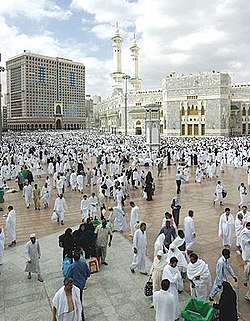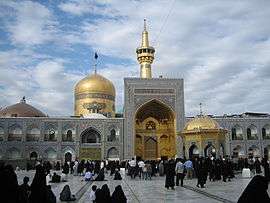Religious tourism

_-_Jul_2008_(cropped).jpg)
.jpg)
Religious tourism, also commonly referred to as faith tourism[1], is a type of tourism, where people travel individually or in groups for pilgrimage, missionary, or leisure (fellowship) purposes. The world's largest form of mass religious tourism takes place in India at the Kumbh Mela pilgrimage, which attracts over 100 million pilgrims. North American religious tourists comprise an estimated $10 billion of the industry.[2]
Modern religious tourists are more able to visit holy cities and holy sites around the world. The most famous holy sites are the Great Mosque of Mecca, the Holy Shrine of Imam Hoseyn in Karbala, the Holy Shrine of Imam Reza in Mashhad, the Holy Shrine of Lady Fatima Masuma in Qom, the Sanctuary of Our Lady of Fátima in Cova da Iria, the Basilica of Our Lady of Guadalupe in Mexico City, the Church of the Nativity in Bethlehem, the Western Wall in Jerusalem and the St. Peter's Basilica in Rome. Religious tourism has existed since antiquity. A study in 2011 found that 2.5 million people visited Karbala on the day of Arbaeen in 2013, pilgrims visited Jerusalem for a few reasons: to understand and appreciate their religion through a tangible experience, to feel secure about their religious beliefs, and to connect personally to the holy city.[3]
Tourism segments
Religious tourism comprises many facets of the travel industry including:
- Pilgrimages
- Marian shrines visits
- Missionary travel
- Leisure (fellowship) vacations
- Faith-based cruising
- Crusades, conventions and rallies
- Retreats
- Monastery visits and guest-stays
- Faith-based camps
- Religious tourist attractions
Statistics
Although no definitive study has been completed on worldwide religious tourism, some segments of the industry have been measured:
- According to the World Tourism Organization, an estimated 300 to 330 million pilgrims visit the world's key religious sites every year.
- According to the U.S. Office of Travel and Tourism Industries, Americans traveling overseas for "religious or pilgrimage" purposes has increased from 491,000 travelers in 2002 to 633,000 travelers in 2005 (30% increase).
- The Christian Camp and Conference Association states that more than eight million people are involved in CCCA member camps and conferences, including more than 120,000 churches.
- Religious attractions including Sight & Sound Theatre attracts 800,000 visitors a year while the Holy Land Experience and Focus on the Family Welcome Center each receives about 250,000 guests annually.
See also
References
- ↑ Gannon, Martin Joseph; Baxter, Ian W. F.; Collinson, Elaine; Curran, Ross; Farrington, Thomas; Glasgow, Steven; Godsman, Elliot M.; Gori, Keith; Jack, Gordon R. A. (2017-06-11). "Travelling for Umrah: destination attributes, destination image, and post-travel intentions". The Service Industries Journal. 37 (7–8): 448–465. doi:10.1080/02642069.2017.1333601. ISSN 0264-2069.
- ↑ Washington Post.com
- ↑ Metti, Michael Sebastian (1 June 2011). "Jerusalem - the most powerful brand in history". Stockholm University School of Business. Archived from the original on 12 June 2011. Retrieved 1 July 2011.
Further reading
- Razaq Raj and Nigel D. Morpeth, Religious tourism and pilgrimage festivals management : an international perspective, CABI, 2007
- Dallen J. Timothy and Daniel H. Olsen, Tourism, religion and spiritual journeys, Routledge, 2006
External links
| Wikivoyage has a travel guide for Religion and spirituality. |
| Wikivoyage has a travel guide for Christianity. |
| Wikivoyage has a travel guide for Islam. |
| Wikivoyage has a travel guide for Judaism. |

